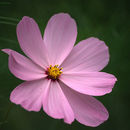Comments
(
الإنجليزية
)
المقدمة من eFloras
Cosmos bipinnatus is native to Mexico and the southwestern United States. A garden favorite, it has escaped and naturalized widely elsewhere in the flora area (and in warm climates almost worldwide), and it has been seeded along roadsides by some highway departments. Many cultivated races and hybrids differ considerably from the wild type described above, varying widely in stature and in coloration of both ray and disc corollas. Some plants in cultivation lack pappi; they are referable to var. exaristatus de Candolle, not treated formally here.
- ترخيص
- cc-by-nc-sa-3.0
- حقوق النشر
- Missouri Botanical Garden, 4344 Shaw Boulevard, St. Louis, MO, 63110 USA
Description
(
الإنجليزية
)
المقدمة من eFloras
Plants 30–200 cm, glabrous or sparsely puberulent, sometimes scabridulous. Leaves: petioles 0 or to 1 cm; blades 6–11 cm, ultimate lobes to 1.5 mm wide, margins entire, apices acute (indurate). Peduncles 10–20 cm. Calyculi of spreading, linear to lanceolate bractlets 6–13 mm, apices acuminate. Involucres 7–15 mm diam. Phyllaries erect, lanceolate to ovate-lanceolate, 7–13 mm, apices round or obtuse. Ray corollas white, pink, or purplish, laminae obovate to oblanceolate, 15–50 mm, apices ± truncate, dentate. Disc corollas 5–7 mm. Cypselae 7–16 mm, glabrous, papillose; pappi 0, or of 2–3 ascending to erect awns 1–3 mm. 2n = 24.
- ترخيص
- cc-by-nc-sa-3.0
- حقوق النشر
- Missouri Botanical Garden, 4344 Shaw Boulevard, St. Louis, MO, 63110 USA

